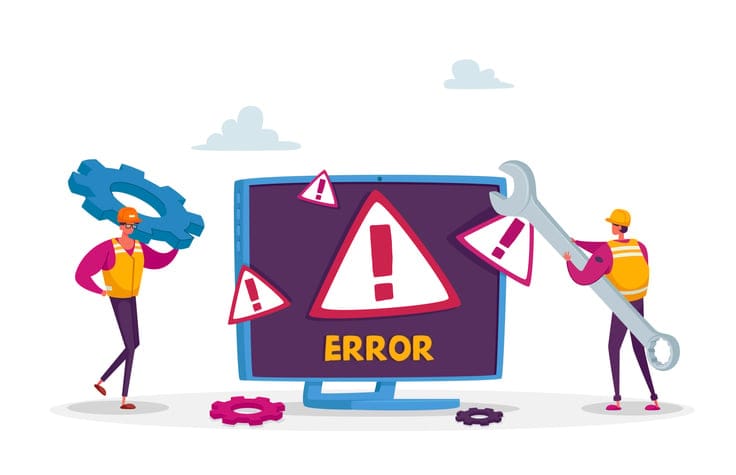
Want to know how much website downtime costs, and the impact it can have on your business?
Find out everything you need to know in our new uptime monitoring whitepaper 2021







We’ve all been there. when you visit a website and you get hit with a three-digit number SMACK in the face. For most, those 3 little numbers mean very little, but it’s definitely worth knowing the most common error codes so you can at least know if your favourite website is down forever, or will be returning in the next five minutes. Equally, if you’re a website owner, marketer, salesperson, IT specialist, or anyone in between, you should definitely know what the error codes mean, and how easy they are to fix.
The reason websites get these infamous error codes is actually pretty simple – no website jargon dictionary needed. For example, when we’re looking for a website, as soon as we search for a URL, the server the URL is connected through will send a response. When there is an issue, we get one of the error codes below and they all indicate a certain issue that the URL or website is having. These can be split into 2 different types of error messages, the client-side (user trying to access the site), and the server-side (the issues with the server).
A 400 error code relates to an issue with the browser. This occurs when the message is identified as corrupt and the request which the server receives cannot respond with the correct requested information.
This error code is related to authorisation credentials. It will usually appear when the user does not have authorisation to enter the page. Luckily, this is something that can be tackled by the user in a few easy steps – sometimes it’s just the cache that needs to be cleared from a browser, and then a trusty old refresh of the chosen page.
A 403 error code is another code that relates to permission. This message will usually appear with the above error code when a user has signed in but does not have permission to access the requested page.
The most famous and well-known error code of them all – the 404. This is a response from the server informing the user that it cannot find the page they are looking for. It’s an indicator of the page not working properly and needs to be fixed. For a website owner, the silver lining to this page is that it’s a great opportunity to make the message into something fun and engaging that could potentially go viral!
Unlike the other error codes, this is a time-out code that the user might have caused by stopping the request before the server has retrieved the information. It can also be an indicator of a slow-running server so it’s best to monitor the server if this message appears.
Like the 404 error code for customers, 500 is the most common error code internally for those monitoring server issues. It usually indicates an issue with the user request not being able to communicate with the server which results in an error 500 message appearing.
This error message indicates something more serious with the server connection. It’s a connectivity issue as the server the user is requesting the information from is not connected and indicates a Bad Gateway problem. A solution to this would be to use a server monitoring tool that can alert you when the server goes down.
If your website is currently offline the users trying to access the server will get this error code. Usually, this occurs when there is planned maintenance work or unplanned downtime on the server.
The timeout error occurs when the server is taking longer than the required period for a response. This error message is generated in this case and it could be an indicator that there is an issue with the server or simply a one-off issue that caused the response time to take longer than usual.
These are just some of the common error codes that you’ll see, both internally and externally. It’s important to know from a customer and from a website owner’s viewpoint what these mean, how they affect customer behaviour, and what can be done to fix them. There are plenty of tools out there that can help minimise these issues, or at least, identify them for you so you can make sure to do something about them. Like StatusCake. Find out everything you need to know about setting up a completely free account here!
Share this

3 min read IPFS is a game-changer for decentralised storage and the future of the web, but it still requires active monitoring to ensure everything runs smoothly.

3 min read For any web developer, DevTools provides an irreplaceable aid to debugging code in all common browsers. Both Safari and Firefox offer great solutions in terms of developer tools, however in this post I will be talking about the highlights of the most recent features in my personal favourite browser for coding, Chrome DevTools. For something

6 min read There has certainly been a trend recently of using animations to elevate user interfaces and improve user experiences, and the more subtle versions of these are known as micro animations. Micro animations are an understated way of adding a little bit of fun to everyday user interactions such as hovering over a link, or clicking

2 min read Read about the latest websites that have experienced downtime including Netflix, Twitter, Facebook and more inside!

2 min read Read about how Google suffered an outage due to the soaring temperatures in the UK in July and how they rectified it right here!

3 min read See the results of our website downtime survey to see some of the most shocking and surprising stats! You won’t be disappointed.
Find out everything you need to know in our new uptime monitoring whitepaper 2021